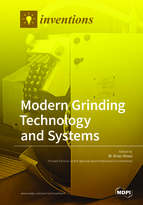Modern Grinding Technology and Systems
A special issue of Inventions (ISSN 2411-5134). This special issue belongs to the section "Inventions and Innovation in Advanced Manufacturing".
Deadline for manuscript submissions: closed (30 April 2018) | Viewed by 70834
Special Issue Editor
Interests: grinding innovations; abrasive processes; abrasive tools; grinding machines; grinding systems; high removal rates; precision; grinding sensors; micro-grinding; flexible grinding systems; coolants and lubricants
Special Issue Information
Dear Colleagues,
This Special Issue will feature key innovations in the science and engineering of new grinding processes, abrasives, tools, machines, and systems for a range of important industrial topics. Topics will, not only feature well-known grinding processes and tools, but also innovations to solve new areas of application. Innovations may range from high-precision kinematics for grinding very large lenses and reflectors, through to medium-sized grinding machine processes, down to grinding very small components used in MEMS. Materials to be ground may include conventional engineering steels to aerospace materials, ceramics, and composites. Papers may also deal with novel topics, such as finishing of parts produced by 3D printing. Innovations may also include new features introduced into control systems to improve process efficiency or to integrate the grinding process more effectively into a wider manufacturing system. Papers will be considered that show significant improvements to any aspect of grinding processes, machines, materials, abrasives, wheel preparation, coolants, and lubricants.
Prof. Dr. W. Brian RoweGuest Editor
Manuscript Submission Information
Manuscripts should be submitted online at www.mdpi.com by registering and logging in to this website. Once you are registered, click here to go to the submission form. Manuscripts can be submitted until the deadline. All submissions that pass pre-check are peer-reviewed. Accepted papers will be published continuously in the journal (as soon as accepted) and will be listed together on the special issue website. Research articles, review articles as well as short communications are invited. For planned papers, a title and short abstract (about 100 words) can be sent to the Editorial Office for announcement on this website.
Submitted manuscripts should not have been published previously, nor be under consideration for publication elsewhere (except conference proceedings papers). All manuscripts are thoroughly refereed through a single-blind peer-review process. A guide for authors and other relevant information for submission of manuscripts is available on the Instructions for Authors page. Inventions is an international peer-reviewed open access semimonthly journal published by MDPI.
Please visit the Instructions for Authors page before submitting a manuscript. The Article Processing Charge (APC) for publication in this open access journal is 1800 CHF (Swiss Francs). Submitted papers should be well formatted and use good English. Authors may use MDPI's English editing service prior to publication or during author revisions.
Keywords
- grinding innovations
- abrasive processes
- abrasive tools and wheel preparation
- grinding new materials
- grinding machines
- grinding systems and controls
- high removal rates
- high precision
- grinding sensors
- micro-grinding
- flexible grinding systems
- coolants and lubricants






